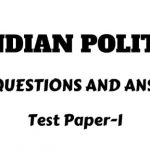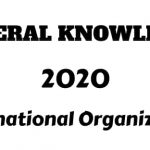Indian Polity and Constitution MCQ Questions and Answers
Test Paper-II
Learn Indian Polity Questions MCQ for Civil Services Examination, SSC, Group I, Group II and Railways examination with MCQ question and answer, Get complete 60 practice Test papers ebook from Fdaytalk ebooks
50 MCQ Indian Polity Questions Practice Paper 2
PlayStation 5 Pro Console
1) Part IX A of Indian constitution provides _____, which were added by the 74th amendment?
a) Panchayat raj system
b) Nagar panchayats raj system
c) both
d) none
Ans: b) Nagar panchayats raj system
2) Which article deals with Indian constitution deals with the suability of the state of India
a) Article 100
b) Article 200
c) Article 300
d) Article 330
Ans: Article 300
3) The chairman of which of the following parliamentary committee is invariably from the members of the ruling party?
a) Committees on public undertakings
b) Public accounts committee
c) Estimates committee
d) Committee on delegated legislation
Ans: Estimates committee
4) Which of the following is not a formally prescribed device available of a member of parliament?
a) Question hour
b) Zero hour
c) Half an hour
d) Short duration
Ans: Zero hour
5) Which of the following is exclusively a committee of the Lower house?
a) Committee on assurance
b) Committee on delegated legislation
c) Committee on delegated
d) Estimates committee
Ans: Estimates committee
6) Central vigilance commission was set up on the recommendation of
a) Administration reforms
b) Gowalla report
c) Kripalani committee
d) Santhanam committee
Ans: Santhanam committee
7) The institution of Lokayukta was created for the first time by the state of?
a) Orissa
b) Bihar
c) Punjab
D) Maharashtra
Ans: Maharashtra
8) The Institution of Lokayukta was created first in Maharastra in
a) 1970
b)1972
c) 1973
d) 1971
Ans: 1971
9) No-confidence motion, to be admitted in the Lok sabha, needs the support of
a) 80 members
b) 140 members
C) 160 members
d) 50 members
Ans: 50 members
10) Which of the following are incorrect about unstarred questions
1) It is distinguished by an asterisk mark
2) Answers to such questions is given orally
3) Answers to such question is not followed by supplementary questions
4) it does not carry asterisk mark
a) 2 & 3
b) 3, 4
c) 1 & 2
d) 2, 3, 4
Ans: 1 & 2
11) In which of the following stated years, the Lokpal bill was not introduced in the parliament?
a) 1968
b) 1971
c) 1978
d) 1985
Ans: 1978
12) Match the following
a) Short Duration Discussion 1) 1964
b) Calling Attention Notice 2) 1962
c) Zero Hour 3) 1953
d) Committee On Public Undertaking Codes 4) 1954
A) 4 3 1 2
B) 3 4 2 1
C) 4 2 1 3
D) 3 2 4 1
Ans : B) 3 4 2 1
13) The final work of UPSC in the recruitment process is
a) Selection
b) Appointment
c) Certification
d) Placement
Ans: Certification
14) The conditions of service of members of all India services determined by
a) President of in India
b) Constitution of India
c) Parliament of India
d) Union service commission
Ans: Parliament of India
15) Constitutional safeguards to civil servants are ensured by
A) Article 310
b) Article 315
c) Article 312
d) Article 311
Ans: Article 311
16) The vote on account is passed
a) After voting the demands
b) Before the general discussion
c) After the general discussion
d) Either after voting the demands or after the general discussion
Ans: After the general discussion
17) Arrange the following states in the enactment of the budget in proper order
1) General discussion
2) Appropriation Bill
3) Finance Bill
4) Voting of demands for grant
5) Presentation of legislature
a) 1 2 3 4 5
b) 5 1 4 2 3
c) 5 1 4 3 2
d) 5 1 3 4 2
Ans: 5, 1, 4, 2, 3
18) Which of the following documents are presented to the legislature along with the budget?
1) An explanatory memorandum on the budget
2) Summary of demands for grants
3) An appropriation bill
4) Finance bill
5) The economic survey
a) 1 ,3, & 5
b) 1, 2, 3, & 5
c) 2, 3 & 5
d) 1, 2, 3 & 4
Ans: 1, 2, 3 & 4
19) The ultimate responsibility of taking due action the comments of the C & AG vests with
a) President of India
b) Supreme court
c) Parliament
d) National development council
Ans: Parliament
20) The number of demands in the general budget for civil expenditure is
a) 109
b) 106
c) 103
d) 102
Ans: 103
21) Which one of the following device calls the attention of minitser towards a matter of public importance
a) Half hour discussion
b) Zero hour discussion
c) Calling attention notice
d) Adjourment motion
Ans: c) Calling attention notice
22) The budget was formally introduced in India in
a) 1860
b) 1947
c) 1950
d) 1868
Ans: 1860
23) the word budget is mentioned in which of the following articles of the constitution of India
a) Art 266
b) Art 112
c) Art 265
d) None
Ans: None
24) The salient features of the government of India Act 1935 are
1) All india federation
2) Provincial autonomy
3) Dyarchy at the center
4) Abolition of dyarchy in the states
a) 1 & 2 b) 1, 2 & 3 c) 2, 3, & 4 d) 1, 2, 3, 4
Ans: 1, 2, 3, 4
25) The planning commission is described as the economic cabinet by
a) PP Agarwal
b) Ashoka Chanda
c) Dr. Gadgil
d) Santhanam
Ans: Ashok Chanda
26) which of the following enjoys the constitutional status
1) Finance commission
2) Planning commission
3) Zonal councils
4) National development council
5) Election commission
6) University grants commission
a) 1, 3, 5 b) 1, 5 c) 1 ,2 ,5 d) 1, 3, 5
Ans: b
27) The features of indian federal system are:
1. Division of powers
2. Separation of powers
3. Independent judiciary
4. Leadership of the prime minister
5. Written constitution
a) 2, 3 ,5 b) 1, 4, 5 c) 1, 2, 5 d) 1, 3, 5
Ans: d
28) Which of the following is not a department under the ministry of home affairs?
a) Department of internal security
b) Department of Home
c) Department of states
d) Department of law and order
Ans: d) Department of law and order
29) Which of the following is not correct about finance commission?
a) Constituted at the expiration of every fifth year
b) Recommends the distribution of proceeds of taxes between centre and states
c) Consists of a chairman and four other members
d) Its advice is binding on the government
Ans: d
30) Which of the following is correctly matched?
a) 1909 Act- Principle of election
b) 1919 Act- Provincial autonomy
c) 1935 Act- Dyarchy autonomy
d) 1947 Act- Responsible government
Ans: d
31) The CAG of India can be removed from the office only in like manner and on like grounds as
a) Chairman of the UPSC
b) Supreme court judge
c) Sttorney general of india
d) Speaker of Lok sabha
Ans: b
32) Discretionary grants are given to states by the centre on the recommendation of
a) Finance commission
b) National development council
c) Finance ministry
d) Planning commission
Ans: d
33) Statutory recognition to the portfolio system was accorded by
a) Indian councils Act of 1892
b) Indian councils Act of 1871
c) Indian councils Act of 1861
d) Indian councils Act of 1882
Ans: c) Indian councils Act of 1861
34) Dyarchy was introduced by
a) Indian councils act of 1909
b) Government of India of 1919
c) Government of India of 1935
d) Independence act of 1886
Ans: b) Government of India of 1919
35) Which of the following is not a feature of Government of India Act of 1935?
a) Dyarchy at the centre
b) All-india federation
c) Provincial autonomy
d) Dyarchy in the provinces
Ans: d
37) The Indian federation is based on the pattern of
a) Switzerland
b) USA
c) Russia
d) Canada
Ans: d
38) Who said as Indian constitution established a unitary state with subsidiary federal features rather than a federal state with subsidiary unitary features?
a) Granville Austin
b) Ivor Jennings
c) B.R Ambedkar
d) K.C Wheare
Ans: d
39) Which of the following are not correct about CAG of India?
1. He is appointed by the president for a period of five years
2. His salary and condition of services are determined by the President
3. He shall vacate office on attaining the age of 60 years
4. He is responsible for maintaining the accounts of the central and state government
a) 1, 3, 4
b) 1, 2
c) 1, 2, 3
d) 1, 2, 3, 4
Ans: d ) 1, 2, 3, 4
40) Which of the following are correct about deputy chairman of the planning commission?
a) He is appointed by the Prime Minister
b) He enjoys the status of a cabinet rank minister
c) He is a member of the union cabinet
d) He attends all cabinet meetings
e) He is the de facto executive head of the commission
A) a, b, c
B) a, d, e
C) b, d, e
D) a, b, c, d, e
Ans: c) b, d, e
41) Which of the following statements are incorrect about Unstarred questions
1) It is distinguished by an asterisk mark
2) Answer to such a question is given orally
3) Answer to such a question is not followed by supplementary questions
4) It does not carry any mark
a) 2 & 3 b) 3, 4 & 5 c) 1 & 2 d) 2, 3 & 4
Ans: C) 1 & 2
42) In which of the following stated years, the Lokpal bill was not introduced in the parliament
a) 1968
b) 1971
c) 1978
d) 1985
Ans: C) 1978
43) The vote on account is passed
a) After voting of demands
b) Before general discussion
c) After the general discussion
d) Either after the voting of the demands or after the general discussion
Ans: c) After the general discussion
44) The final work of UPSC in the recruitment process is
a) Selection
b) Appointment
c) Certification
d) Placement
Ans: c) Certification
45) The conditions of services of members of All- India services are determined by
a) President of India
b) Constitution of India
c) Parliament of India
d) Union public service commission
Ans: c) Parliament of India
46) Constitutional safeguards to civil servants are ensured by
a) Art.310
b) Art.315
c) Art.312
D) Parliament of India
Ans: D) Parliament of India
47) The number of demands in the general budget for civil expenditure is
a) 109
b) 106
c) 103
d) 102
Ans : C) 103
48) The budget was formally introduced in India
a) 1860
b) 106
c) 103
d) 102
Ans : C) 103
49) The salient features of the government of India act, 1935 are
a) All India federation
b) Provincial autonomy
c) Diarchy at the centre
d) Abolition of dyarchy in the states
a) 1 & 2 b) 1, 2 & 3 c) 2 ,3 & 4 d)1 ,2 ,3 & 4
Ans : D
50) Which of the following Writs is not provided in constitutioin of India
A) Prohibtion
B) Mandamus
C) Quo Warranto
D) Injection
Ans : D) Injection
Get More Indian Polity Questions, 60+ Practice Test Paper of Indian Polity and constitution from below links
Learn More
Link 1: Indian Polity and constitution Mock Test Papers
Link 2: Indian Polity Notes
Link 3: Indian Polity eBook Download



Awesome post! Keep up the great work! 🙂